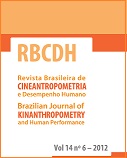Monitoramento da carga interna de treinamento em jogadores de futsal ao longo de uma temporada
DOI:
https://doi.org/10.1590/1980-0037.2012v14n6p671Resumo
Existe a necessidade de estudos sobre métodos para controle da carga e descrição da periodização em equipes de futsal. O objetivo do estudo foi descrever e analisar a carga interna de treinamento em um macrociclo de futsal utilizando-se o método de Percepção Subjetiva do Esforço da sessão. A amostra foi composta por 13 atletas de Liga Nacional. Calculou-se carga de treinamento semanal total (CTST), monotonia e strain durante 37 semanas. Utilizando Teste t de Student pareado, o período de preparação (PP) apresentou CTST, strain e monotonia maiores que o competitivo (PC). Utilizando ANOVA de medidas repetidas, seguida pelo post-hoc de Bonferroni, observaram-se diferenças significativas para CTST entre mesociclos: 1 > 2, 4, 5, 6, 8, 9; 7 > 4, 5, 8, 9; 2, 3 e 6 > 5, 8, 9; 4 > 5; 8 > 5 (p>0,05). As cargas de treinamento (CT) foram mais elevadas no PP com redução no PC. A CT apresenta uma característica ondulatória, adaptando-se ao calendário competitivo.
Downloads
Publicado
Edição
Seção
Licença

Direitos Autorais para artigos publicados nesta revista são do autor, com direitos de primeira publicação para a revista. Em virtude da aparecerem nesta revista de acesso público, os artigos são de uso gratuito, com atribuições próprias, em aplicações educacionais e não-comerciais, desde que seja dada a atribuição. Esta obra foi licenciada com uma Licença Creative Commons Atribuição 4.0 Internacional - CC BY


